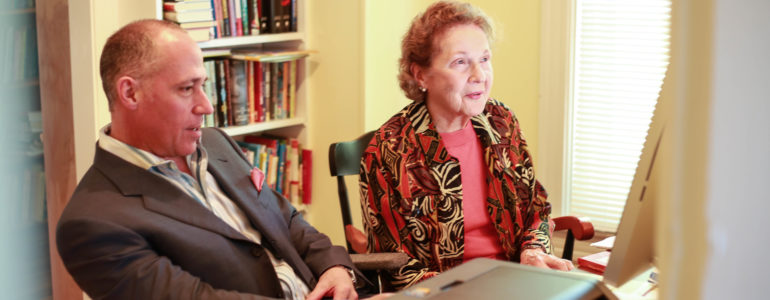Laura Robb
Though we are social beings who crave relationships and meaningful interactions with others, we also relish having time alone. And that’s a good thing. Alone time cultivates reflection, the ability to raise questions and to look back at an experience, think deeply about it, and gain self-knowledge.
Recently, Gracie, a fifth grader, and her group finished reading Stone Fox by John Reynolds Gardiner. Gracie closed her eyes for a few moments, hoping more pages would pop into the book. “There has to be more,” she blurted out. “It can’t end. I want to know what happened after Searchlight died.” Gently, her teacher reminded Gracie that she could imagine what happened by extending the end of the story in her mind, and she could continue to think about what she had learned from the characters and events.
Gracie and her teacher illustrate what reflecting about reading looks like, and how reflection can boost students’ connections to characters, conflicts, problems, and new information. But it can also do more. Gracie and her group developed empathy for being an orphan and little Willy shouldering adult responsibilities.
Defining Reflection
Reflection is the act of thinking about something and can be a personal experience like planning a vegetable garden, mulling over a book during and after reading or thinking about a movie or play. A powerful learning and imagining tool, reflection enhances experiences by deepening our insights, helping us make sense of new information, and making it possible to use prior knowledge to create new understandings. Those who reflect experience joy in reading, learning, and daily life. They also develop agency and the capacity for positive change.
A solo activity, reflection is unique to each person’s experiences and prior knowledge. It’s also meta-cognitive, providing a learner with knowledge about processing information, connecting to past experiences, and transferring learning to new situations. However, reflecting is individualized thinking and learning that requires modeling and practice.
Promoting Reflective Classrooms
Teachers who squarely see the benefits of questions and reflection in their lives can become the intermediary in developing the habit of raising questions and reflecting among students. When teachers reflect on lessons, observations of and conferences with students, they collect stories and information that can support scaffolding learning and provide insights into students’ behavior and attitudes. It’s helpful to set aside ten to fifteen minutes each day to think about what worked and what you can do to increase students’ engagement and desire to learn.
Reflecting on Teaching: For me, the level of success in a class has everything to do with students’ engagement in the work and their motivation to work hard and learn. By cultivating the habit of thinking about each teaching day, you can celebrate successes as well as repair areas that require attention. The questions that follow encourage reflecting on teaching:
- How can I help students become more involved in their learning?
- Why were most students engaged, and a few disengaged?
- How do I involve students in planning learning experiences?
- Do students offer input and feedback on using technology on the classroom?
- Why is it important to invite students to help decide how to arrange our classroom for project-based learning, book discussions, genius hour, collaborative planning?
- Am I giving students feedback that helps them improve?
- Are students doing most of the talking and work? If not, how can I flip this?
- Is choice a part of independent and instructional reading? Of collaborative projects? Of presentations?
- Does the way I use technology enhance students’ learning?
- Am I effectively modeling how to reflect on reading, on a discussion, a collaborative project, and on the use of technology?
Nurture your curiosity and ask questions to examine your teaching and students’ learning. Your questions can help you resolve issues independently or more likely, send you to colleagues for suggestions. When you wonder why a student didn’t absorb a lesson or why a child misbehaves or can’t complete a task, you’ve taken the first step to explore ways to scaffold and support. Be curious. Wonder. Find the path to help yourself and students grow.
Students Reflecting on Learning
To help students actively reflect on a lesson or work they’ve been doing, first invite them to silently think about their work. To guide students, make your inner voice visible and think aloud to show them how you might consider the task. You can say something like: I wish I had set aside more time to work on projects today because 20 minutes wasn’t enough; I’ll do better tomorrow. Or We don’t seem to get to independent reading every day, I’m considering starting the class with it. Doing this builds students’ mental model of what reflective thinking is like. Point out that frequently reflection can lead to a decision that improves learning and use of time.
Have pairs generate and share questions, write these on chart paper, and invite students to choose one or two. The goal is for students to integrate reflective questioning while working on a task or project, and after it’s completed. What follows is a list of some learning experiences for student reflection. You and students will pinpoint many more.
- Writing Tasks
- Reviewing Notebook Entries
- Participating in Small-Group Discussions
- Preparation for Lessons
- Contributions to collaborative learning projects
- Book talks
- Taking notes
- Project-based learning
- Genius Hour
- Active listening during discussions
- Silent reading
- Stamina
- Quarterly review of portfolios
Reflection as a Tool for Change
Reflective questioning deepens understanding and can lead to positive changes. When you and your students reflect and then express what you learned, thinking moves beyond the experience to self-knowledge and transfer to other learning and life situations.
Follow Laura on Twitter @LRobbTeacher
Check out Evan’s blog posts on ScholasticEDU!
Learn more about Laura’s ideas on reading- check out- Teaching Reading in Middle School

![]()













